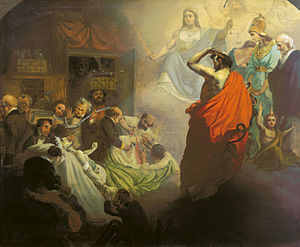User:Victoria/sandbox

"Homeopathy looks at the horrors of Allopathy" — an allegorical painting by Russian artist Alexander Beideman, painted in 1857. Owned by the State Tretyakov Gallery (inv. 1795). picture size - 65,5 × 77,3 cm . In XIX century the painting was also known as "Triumph of homeopathy"[1].
History[edit]
The allegorical image [1] "Homeopathy, Allopathy looks at the horrors" was painted by Alexander Beydemanom in Munich in 1857 [2]. According to the homeopath Nicholas Gabrilovich (1865-1941), the painting was commissioned by his father, Eugene Gabrilowitsch (1835-1918), who at that time studied in Munich. The canvas was acquired by Pavel Tretyakov before 1893. In 1923, the picture was exhibited at the Tretyakov Gallery at an exhibition dedicated to the 25th anniversary of the death of Pavel Tretyakov Cite error: A <ref> tag is missing the closing </ref> (see the help page)..
Description[edit]
"The positive pole of the scene" is located in the right part of the picture. In the background an allegory of soaring in the clouds Homeopathy. In front of her in a red cloak, the god of medicine Aesculapius with his left hand raised in anger and indignation. Behind him, the goddess Athena, which protects the sciences, and at the right edge of the canvas is the German physician Samuel Hahnemann (1755-1843), the founder of homeopathy. [4] All of them look with disapproval and indignation at associated with allopathy (modern medicine) "negative pole," located on the left side of the picture where doctors mistreat a patient. One of them is sawing off the patient’s leg. The figure of Death is waiting for patient’s demise in the doorway. Patient’s wife sobbing and crying children depicted in the lower left corner [3].
Sources[edit]
- ^ a b Государственная Третьяковская галерея — каталог собрания. Vol. 4: Живопись второй половины XIX века, книга 1, А–М. Moscow: Красная площадь. 2001. ISBN 5-900743-56-X.
{{cite book}}: Unknown parameter|agency=ignored (help) - ^ А. Г. Верещагина. (1958). "Александр Егорович Бейдеман" (Русское искусство: очерки о жизни и творчестве художников. Середина XIX века. ed.). Москва: Искусство: 275–286.
{{cite journal}}: Cite journal requires|journal=(help); Unknown parameter|agency=ignored (help)CS1 maint: date and year (link) - ^ Г. В. Ельшевская. "Альтернативная история живописи XIX века. Восемь картин, которые никогда не попадут в академические учебники" (HTML). arzamas.academy.

